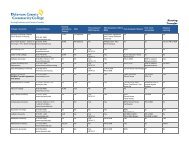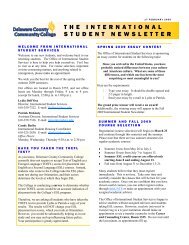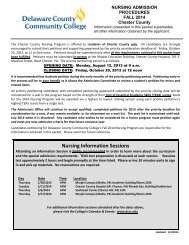2010 Catalog - Delaware County Community College
2010 Catalog - Delaware County Community College
2010 Catalog - Delaware County Community College
Create successful ePaper yourself
Turn your PDF publications into a flip-book with our unique Google optimized e-Paper software.
110 COURSE DESCRIPTIONS<br />
• Utilize pharmacological agents in management of the<br />
respiratory system.<br />
• Utilize manual and mechanical interventions in<br />
management of the respiratory system.<br />
• Distinguish between respiration, pulmonary ventilation,<br />
and external and internal respiration.<br />
• Describe pulmonary circulation.<br />
• Describe voluntary, chemical, and nervous regulation<br />
of respiration.<br />
• Outline essential parameters to evaluate the effectiveness<br />
of airway and breathing.<br />
• Describe the indications, contraindications, and<br />
techniques for supplemental oxygen delivery<br />
• Discuss methods for patient ventilation.<br />
• Describe the assessment techniques and devices<br />
used to ensure adequate oxygenation.<br />
Prereq. EMS 100<br />
3 Credits 2 Weekly Lecture Hours<br />
1 Weekly Laboratory Hours<br />
EMS 136 Special Considerations -<br />
Assessment Based Management Seminar<br />
This course is designed to prepare the student to perform<br />
and manage an effective assessment of the patient care.<br />
Topics such as integrating pathophysiological principles,<br />
physical examination findings, formulating a field<br />
impression and implementing treatment for the patient<br />
with common complaints will be thoroughly discussed.<br />
Additionally, the student will be exposed to the appropriate<br />
procedures to gather, evaluate and synthesize information<br />
as well as make appropriate decisions based on that<br />
information and take the necessary action for patient care.<br />
Upon successful completion of this course, students<br />
should be able to:<br />
• Discuss how assessment-based management contributes<br />
to effective patient and scene assessment.<br />
• Describe factors that affect assessment and decision<br />
making in the pre-hospital setting.<br />
• Outline effective techniques for scene and patient<br />
assessment and choreography of patient assessment and<br />
personnel management.<br />
• Identify essential take-in equipment for general and<br />
selected patient situations.<br />
• Outline strategies for patient approach that promote an<br />
effective patient encounter.<br />
• Describe techniques that permit efficient and accurate<br />
presentation of the patient.<br />
3 Credits 2 Weekly Lecture Hours<br />
2 Weekly Laboratory Hours<br />
EMS 140 Trauma Systems and<br />
Mechanism of Injury<br />
This course is designed to provide the student with the<br />
knowledge and skills to recognize the mechanisms of injury,<br />
trauma systems, patient assessment and emergency care.<br />
The course will also cover, in detail, the importance of the<br />
length of time that elapses between the incident and definitive<br />
care. Additionally, the course addresses the major roles<br />
in death reduction in three periods of trauma: through<br />
community education, scene interventions, and rapid<br />
response. Trauma systems, appreciation of comprehensive<br />
trauma systems, blunt trauma, and penetrating trauma will<br />
be thoroughly discussed.<br />
Upon successful completion of this course, students<br />
should be able to:<br />
• Describe the incidence and scope of traumatic injuries<br />
and deaths.<br />
• Identify the role of each component of the trauma system.<br />
• Predict injury patterns based upon knowledge of the<br />
laws of physics related to forces involved in trauma.<br />
• Describe injury patterns that should be suspected when<br />
injury occurs from blunt trauma.<br />
• Describe the role of restraints in injury prevention and in<br />
injury patterns.<br />
• Discuss how an organ's motion may contribute to injury<br />
in each body region depending on the forces applied.<br />
• Identify selected injury patterns associated with<br />
motorcycle and all-terrain vehicle (ATV) collisions.<br />
• Describe injury patterns associated with<br />
pedestrian collisions.<br />
• Identify injury patterns associated with sports injuries,<br />
blast injuries, and vertical falls.<br />
• Describe factors that influence tissue damage related to<br />
penetrating injuries.<br />
5 Credits 3 Weekly Lecture Hours<br />
4 Weekly Laboratory Hours<br />
EMS 202 Emergency Medical<br />
Management of Patients Contaminated<br />
by Hazardous Materials<br />
This course will provide the students with the<br />
information necessary to assess and properly manage the<br />
threats to self, co-workers and patients posed by victims<br />
contaminated by hazardous materials. Recognition and<br />
identification of the hazardous materials posing the threat<br />
will be stressed. In addition, steps necessary to comply<br />
with consensus and regulatory standards such as OSHA<br />
1910.120 and JCAHO are presented.<br />
Upon successful completion of this course, students<br />
should be able to:<br />
• Describe the means by which the hazardous materials<br />
contaminating the victim may be identified.<br />
• Employ reference manuals and sources to determine an<br />
appropriate pre-hospital medical protocol for initiating<br />
patient care.<br />
• Demonstrate contamination reduction practices necessary<br />
to protect emergency response staff.<br />
• Demonstrate appropriate procedures for decontaminating<br />
the victim prior to initiating patient care.<br />
• Demonstrate ability to select and utilize appropriate<br />
hazardous materials personal protective equipment.<br />
• Describe record keeping procedures necessary to<br />
establish an OSHA-required hazardous materials<br />
exposure file for each responder exposed to the<br />
hazardous material.<br />
1 Credit<br />
EMS 203 Introduction to Advanced<br />
Life Support I<br />
This course is designed to provide the student with the<br />
necessary knowledge of the roles and responsibilities of<br />
advanced life support systems and procedures. Topics such<br />
as medical/legal ethics, drug information, the cardiovascular<br />
system, and proper medication administration will be<br />
presented. Experiments and case studies will be presented<br />
during this course.<br />
Upon successful completion of this course, students<br />
should be able to:<br />
• Define the roles and responsibilities of the paramedic in<br />
the Emergency Medical Service (EMS) system as they<br />
relate to history, system development, education,<br />
research, and continuous quality improvement.<br />
• Describe the individual's role in providing emergency<br />
patient care.<br />
• Outline the individual's role in promoting community<br />
health education, wellness, and prevention.<br />
• Identify professional, ethical, legal and moral<br />
accountability issues and situations.<br />
• Identify the proper use and administration of drugs for<br />
various body systems.<br />
Prerequisite: BIO 150 – Human Anatomy and Physiology I,<br />
Certification as a curent Emergency Medical Technician<br />
4 Credits 3 Weekly Lecture Hours<br />
2 Weekly Laboratory Hours<br />
EMS 205 Introduction to Advanced<br />
Life Support II<br />
This course is a continuation of Introduction to Advanced<br />
Life Support I and is designed to stress practices applicable<br />
to the paramedic practitioner. Emphasis will be placed on<br />
medication application, pharmacology and therapeutic<br />
concepts and practices. Various approaches are covered to<br />
ensure that the student receives broad exposure to all<br />
areas required for the paramedic practitioner. Experiments<br />
and case studies will be presented during this course.<br />
Upon successful completion of this course, students<br />
should be able to:<br />
• Identify the components of human anatomy and<br />
physiology as they relate to care for the sick or injured.<br />
• Explain pharmacological characteristics, mathematical<br />
principles and purpose in administering pharmacological<br />
agents.<br />
• Identify communication strategies necessary to collect<br />
information, interview and assess patients.<br />
Coreq. EMS 203<br />
2 Credits 1 Weekly Lecture Hours<br />
2 Weekly Laboratory Hours<br />
EMS 210<br />
Medical Emergencies I<br />
This course is designed to prepare the paramedic student<br />
to manage numerous types of medical emergencies. Topics<br />
including the etiology and epidermiology of cardiopulmonary<br />
diseases and conditions will be discussed as well as<br />
the means to identify and describe the function of the<br />
cardiopulmonary system.<br />
Upon successful completion of this course, students<br />
should be able to:<br />
• Identify the risk factors and prevention education of<br />
cardiovascular disease processes.<br />
• Distinguish pathophysiology of respiratory emergencies<br />
related to ventilation, diffusion, and perfusion.<br />
• Assess causes, complications, and conditions of the<br />
cardiopulmonary system.<br />
• Describe the anatomy and physiology of the<br />
cardiopulmonary system.<br />
• Identify the electrophysiology of the cardiac system.<br />
• Describe cardiovascular disease processes.<br />
• Distinguish among varied techniques in managing<br />
cardiac and pulmonary emergencies.<br />
• Apply emergency intervention on patients suffering from<br />
cardiopulmonary conditions.<br />
• Describe anatomy and physiology of the nervous system.<br />
• Identify disorders of the nervous, endocrine, and<br />
gastrourinary systems.<br />
• Identify neurological disorders.<br />
• Describe causative agents and the pathophysiology of<br />
ingested poisons.<br />
• Assess acute abdominal pain. Specify disorders of the<br />
endocrine system.<br />
• Describe the anatomy and physiology of the<br />
endocrine glands that assist the body in the<br />
maintenance of homeostasis.<br />
• Describe the antigen antibody response.<br />
• Describe signs and symptoms and management<br />
of allergic reactions.<br />
• Describe signs and symptoms, complications, and<br />
pre-hospital management of gastrointestinal disorders.<br />
Credits<br />
3 Weekly Lecture Hours<br />
2 Weekly Laboratory Hours<br />
EMS 211<br />
Medical Emergencies II<br />
This course is a continuation of Medical Emergencies I,<br />
and it is designed to provide the student with additional<br />
information necessary to effectively perform in medical<br />
emergency situations. Emergencies pertaining to neurology,<br />
endocrinology, allergies and anaphylaxis, gastroenterology,<br />
urology, and toxicology will be discussed. In addition, topics<br />
include, but are not limited to, hematology, environmental<br />
conditions, and behavioral disorders.<br />
DELAWARE COUNTY COMMUNITY COLLEGE

















